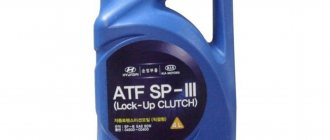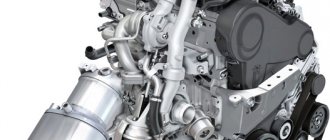Functions of gear oil
Before talking about the classification and main characteristics, it is necessary to find out what tasks this working fluid performs. Such oil is necessary to solve several problems:
- Lubrication of parts. There are dozens of moving parts in a transmission design. To reduce their wear, while ensuring correct and smooth operation, transmission oil is needed. If it is not changed in a timely manner, a large amount of metal shavings will form in the gearbox, which can disrupt the operation of the unit.
- Heat removal. Without gear oil, the gearbox parts would simply overheat. High temperatures also negatively affect parts as well as their service life.
- Corrosion protection. Modern products include many elements that help improve metal protection against corrosion.
- Reduced gearbox noise and vibrations. The operation of the gearbox is associated with various noises that cause inconvenience to the driver and passengers when driving. Oil can significantly reduce noise levels.
As you can see, the use of gear oil is mandatory. It helps extend the life of the gearbox and also prevents breakdowns.
Difference between GL-4 and GL-5 gear oil
API GL-4 oils are used for bevel and hypoid gears (gearboxes), as well as for drive axle differentials operating at moderate speeds and loads. API GL-5 standard oils are used for high-speed hypoid gears and drive axles operating at high temperatures and heavy loads.
Most imported and domestically produced gear oils use additives containing sulfur, phosphorus, halogens and, most often, chlorine. This composition has an aggressive effect on the metal, forming compounds that have lower shear resistance during operation and lower melting temperatures than pure metals. Subsequently, sticking and seizing of contacting surfaces is prevented.
Oil Viscosity: Definition and Importance
Drivers can find a huge selection of oils in the store and on the market. Modern industry produces mineral, semi-synthetic and synthetic oils. Each of them has its own characteristics and features. When choosing products, you should definitely pay attention to such an indicator as viscosity.
This parameter allows you to determine whether this liquid is suitable for use in a particular temperature range. Essentially, this is the ability of oil to maintain fluidity between parts. We all know that this working fluid thickens when temperatures drop, making the lubrication process impossible. For this reason, it is naturally necessary to select the right oil. You can always find purchasing recommendations in the technical description of your car. Additionally, you can consult specialized forums for your car model.
Gear oil 75W90, 85W90, 80W90 or 75W140 - which one to choose
The other oil tested had a viscosity of 80W90. Its average value gave the number 4122Н, which is already much better. Transmission oil 75W90 showed even better results. Here the values ranged from 3685 to 5204N, and the average was 4508N, which was certainly pleasing.
The result will be seen more clearly in numbers. The welding load on a conventional 4-ball friction machine reveals the ability to hold a critical load. According to it, oils are divided into groups. Thus, GL 3 has a minimum value of 2760N, gear oil 75W90 - GL 4 - 3000N, and GL 5 - 3280N.
International classification according to SAE
How to determine the viscosity of an oil, because it is impossible to measure this parameter using a ruler or other tool. This question was asked by specialists from the American Society of Engineers. The result of their work was the creation of a generally accepted standard. The SAE index indicates the viscosity of the oil, while allowing car owners to select the products that are necessary for their foreign car. Using this index, you can determine the highest and lowest temperatures at which the oil can be used.
According to SAE standards, gearbox oils are divided into two main categories:
- winter (in their marking they have the English letter W - Winter), for example, 70w, 75w
- summer (without index), for example, 80, 85, 140.
There are also all-season oils (which are what we are talking about), which are labeled with two numbers separated by the English letter W. Such products can be used by drivers throughout the year.
In this marking, the first number (for example, 80W) shows the viscosity class at subzero temperatures (also called winter viscosity). The second indicator after the letter W is the viscosity class at positive temperatures (or summer viscosity). The first number in the marking indicates the viscosity of cold oil, and the second indicates the viscosity of hot oil. The smaller the first parameter and the larger the second, the better. A small first number ensures ease of gear movement in sub-zero temperatures, and a large second number guarantees high strength of the film being created.
Transmission oil 75w90 and 80w90 - what is the difference
The following information is more of a reminder, but perhaps there will be others for whom it will be something of a “discovery.” So, everyone knows that if the liquid is all-season, then it is double marked (75w90, 80w90), but only some know how to correctly decipher it. To make it more clear, let's look at an example. Let's take, say, the 85w90 marking. A designation of this type indicates that the oil is all-season and has two viscosity characteristics: 85w and 90. The 85w indicator, also known as “winter,” indicates the fluidity of the liquid at low temperatures. The lower the “w” designation, the more fluid the oil is in the cold season. As for the second “summer” indicator “90”, it indicates the viscosity range that the gear oil must correspond to at a temperature of 100°C. The lower the “winter” indicators, the more fluid the liquid is and, accordingly, the thinner the oil film that forms on the surface of the mechanism. What does it mean? This means that better protection is provided for transmission parts during cold starts.
Today we will talk about all-season gear oil, its viscosity, and also consider the main representatives of “all-season” gear oil, in particular, 75w90 and 80w90 gear oil. May the most impatient and curious forgive us, but before proceeding to the main “debriefing”, we suggest that you plunge a little into the theory.
Oil comparison
Once we have defined what viscosity is and understood the principle of labeling gear oils, we can move on to comparing different products. So, the first number indicates the minimum temperature at which this oil can be operated. Thus, products 75W90, 75W85 and 75W85 have a common parameter (temperature of -40 degrees Celsius). The second indicator indicates viscosity at positive temperatures. For 75W85 and 75W85 this figure is 35 degrees Celsius, and for 75W90 the maximum temperature reaches 45 degrees.
If we compare 80Wxx products with 75W90 products, then the differences will already be in sub-zero temperatures. 80Wxx oils have a lower limit of -26 degrees. 80W90 products have an upper temperature limit of 45 degrees. The maximum lower temperature parameter is observed in 85W90. In winter, temperatures should not fall below -10 degrees for this type of oil to work correctly. A distinctive advantage of this oil model is the ability to perform its functions in extreme heat even above +45.
Products with an index of XXW90 are ideal for temperate climates. Oil 75W-90 is used in severe frosts. Properly selected gear oil will also affect control. Changing gears will be much easier. The driver will have to make a minimum of effort.
When purchasing, you should also pay attention to the type of oil. For example, there is such a division:
- 85W-90 are typically thick mineral oils.
- 80W-90 is also mineral oil, but with greater fluidity.
- 75W-90 – synthetic or semi-synthetic medium thickness.
As drivers' experience shows, 75W-90 oil is optimal for moderate climates. It retains its characteristics over a wide temperature range and practically does not oxidize.
What are the differences between 75w90 and 80w90?
In this version of the comparison of two transmission oils, it is no longer the positive temperature range that comes to the fore, but the negative one. Thus, liquid marked 75W90 can be used even at -40 degrees. And the permissible operating limit for 80W90 gear oil is -26 degrees.
With the correct selection of gearbox fluid, driving a vehicle can be significantly simplified due to much quieter operation of the transmission system. In this case, minimal effort will be required from the driver to change gear.
Main types
As mentioned earlier, in addition to separation by viscosity, the presented oils can belong to one of three groups:
- mineral;
- synthetic;
- semi-synthetic.
The former are usually used in old cars with a service life of more than 15 years. They are marked with the word Mineral. This is an environmentally friendly product and also the most affordable. At the same time, in terms of its characteristics, it is significantly inferior to the other two classes. Mineral oil quickly oxidizes and thickens when exposed to low temperatures.
Synthetic oil does not have all these disadvantages. The product has the best cleaning and protective properties, and also includes many additional additives that improve the characteristics of the oil. Synthetics work great at both low and high temperatures. The only downside is the high price.
Semi-synthetic products are a kind of “golden mean”, as they have performance characteristics close to synthetics, but at the same time a more affordable price. The products are created on a mineral basis, but contain many additives.
Transmission oils of different viscosities
Among motor oils, a completely artificial synthetic base has long gained the greatest popularity. They are also followed by transmission oils 75W90, 85W90, 75W140. Most synthetic-based lubricants can be used for a whole year. Even at very low temperatures they will produce good functional results. For example, if you compare mineral water 85W90 at negative twelve degrees with synthetic 75W140 in the cold at forty degrees, the result in terms of viscosity will be practically indistinguishable. And if they are placed in the same temperature regime of -20 degrees, the result will be 30-50 times different. This is a very serious matter. It turns out that in one case the engine will barely start, and in the other - almost like in the warm season.
Good to know: API classification
When purchasing gear oil, drivers may also encounter API markings. There is no single classification for quality, performance characteristics and application, but API is the closest to it. It contains a comprehensive assessment of the performance qualities of lubricants.
Almost all modern cars use GL-4 or GL-5 oils. The former are suitable for mechanics and gearboxes that use hypoid or spiral-bevel pairs. Such oils are actively used in temperate climates. GL-5 is suitable for use in harsh conditions on various types of gears. There is also a GL-6 group designed for the harshest conditions.
Transmission classes
Gl group lubricants belong to the hypoid type. That is, they lubricate rear axles and individual gearboxes of such domestic car brands as Zhiguli, Niva, Volga. For trucks, of course, it is also suitable, but it will be too expensive.
The most common gear oil has a viscosity grade of 75W90. The exceptions included Castrol brand oils. Their line includes lubricants 85W90 and more liquid 80W90. In addition, next to the GL 5 75W90 was 75W140 transmission oil. This last viscosity option is not very suitable for Russian cars. It is usually poured into rear and all-wheel drive versions, as well as into models with a locking differential. They will most likely serve well on a Patrol or Land Cruiser, but for domestic ones they will be too thick. There is no point in filling them during normal operation. But if the rear axles are “singing,” then such a lubricant may be just right for them.
But if inexpensive mineral water does its job perfectly, why spend extra money on synthetics?
What to look for when choosing
The purchase of oil should be based not only on any classifications, but also on several other parameters. High-quality gear oil should:
- prevent high friction and increased wear on the surfaces of gears or other transmission components;
- carry out heat removal;
- stop or minimize the oxidation process;
- do not react with water;
- maintain original properties during long-term storage;
- reduce noise and vibrations,
- do not emit toxic fumes when heated.
The oil according to the markings may satisfy your needs, but if it does not perform the tasks described above, it will lead to gearbox failure. Here you should choose products from official manufacturers or well-known brands that have proven themselves positively in the market.
Decoding and comparison of 75w80 oil
- Mineral. Inexpensive motor oils in which the main liquid is processed petroleum products. Considered to be of the lowest quality;
- Synthetic. Produced through the synthesis of chemical components. Quite expensive;
- Semi-synthetic. They are made from mineral water, to which various additives have been added to improve performance. They represent an excellent combination of price and quality.
Another characteristic feature of transmission oil is foaming. The service life of the lubricant depends on it. You need to choose an oil that produces little foam. Foam prevents the oil from performing its main function - covering all parts with a lubricating film. Due to this, parts of the gearbox are subject to corrosion, because oxygen comes into contact with metal parts. The tendency to form foam must be taken into account.
Is it possible to mix 75W-85 and 75W-90 oils?
Automotive oils that pass API certification are compatible with each other. It is worth remembering that if you mix viscosity 75W-85 and 75W-90, you end up with an intermediate viscosity.
At the same time, there is an opinion that mixing oils with different viscosities implies a conflict of additives, which can lead to significant damage to the gearbox due to a negative chemical reaction and the appearance of sediment (whitish flakes). This sediment clogs the entire transmission system.
Therefore, if you urgently need it, you can mix 75W-85 and 75W-90, nothing significant will happen. But it’s better to fill in one manufacturer and one viscosity, which is recommended in the car’s instructions, and completely change the oil in the box as soon as possible.
What is the difference between 75w80 oil and 75w90
The main feature of the working fluids under consideration is the scope of application. Thus, GOST 17479.2-85 states that GL-4 is a type of oil that is suitable for mechanisms with hypoid and bevel type gears. Temperature limits are 150 degrees Celsius, and voltage limits are 3000 MPa. In other words, this gear oil is used for cars with front-wheel drive.
The lubricating fluid that is poured into the gearbox, drive axle or transfer case is usually called transmission fluid. The classification of such a product is in many ways similar to the classification of engine oil, which, to some extent, simplifies the purchasing process. When choosing gear oil, you should focus on a number of criteria:
Liqui Moly in Kazan › Blog › Gearbox oil
In this matter, everything, first of all, depends on the type of transmission in your car. Mechanics (manual transmission), Automatic (automatic transmission), CVT (CVT), Robot (robotic transmission). In the case of a manual transmission, the first warning sign is often the resistance of the manual transmission lever when shifting. This is especially noticeable in cold weather. In the case of an automatic transmission, CVT or robot, a sure sign of the need for replacement is increased jerks and impacts when switching.
All-season oils are designated by a code with two numbers, for example, 20W-50. They satisfy the appropriate classes for different seasons. For all-season oil - double number. The first is viscosity at negative temperatures. The second is viscosity at positive temperatures.
What's the result?
Transmission oils are classified according to two indicators: viscosity and performance properties. The first indicates the temperature range of application, and the second indicates the additives and additives contained, as well as the area of application.
In this case, the choice of oil for a manual transmission or ATF for an automatic transmission will be helped by a table of viscosity of transmission oils and classification according to API. Using the data, you can select an analogue of the lubricant filled in by the car manufacturer at the factory, without the risk of damaging the gearbox or reducing the life of the unit.
Which gear oil is better to use: test results and reviews
In the first case, the oil is characterized by good fluidity and cleaning properties. But its price is higher. Mineral oil thickens quickly at low temperatures. It is recommended to be used only in old-style machines. Under such conditions, carbon deposits that form mineral oil further insulate the seals. Consumables will not leak out during vehicle operation.
The best in this class of consumables, according to experts, are TOTAL (570 rubles/l), Castrol Axle EPX (270 rubles/l), Lukoil TM-4 (132 rubles/l). Experienced auto mechanics especially recommend the first remedy listed. Its characteristics meet modern requirements of domestic cars.
The right choice of gear oil with the best performance
This is a very twofold criterion, the attitude towards which must be developed individually by each car enthusiast. If the viscosity is high, that is, the substance is thick, this helps to increase the service life of the gearbox. However, if the viscosity of the substance is low, then this will reduce the energy required for friction. Most experts say that the higher the viscosity index, the better the product.
- Standard GL-1. It is better to use such liquids when operating a passenger car in uncomplicated conditions.
- Standard GL-2. It is not recommended to pour it into passenger cars. But it is ideal for use in agricultural trucks.
- Standard GL-3. Also intended for use in trucks. However, it must be operated in moderately difficult conditions.
- Standard GL-4. One of the most famous and frequently used TM standards. Why? Because it is universal and can be used in any technique.
- Standard GL-5. Perhaps the second most popular. It has excellent characteristics. This standard should also be classified according to viscosity. There are thick liquids (SAE 85W-90), medium-thick liquids (SAE 80W-90) and the thinnest synthetic and semi-synthetic products (SAE 75W-90).









